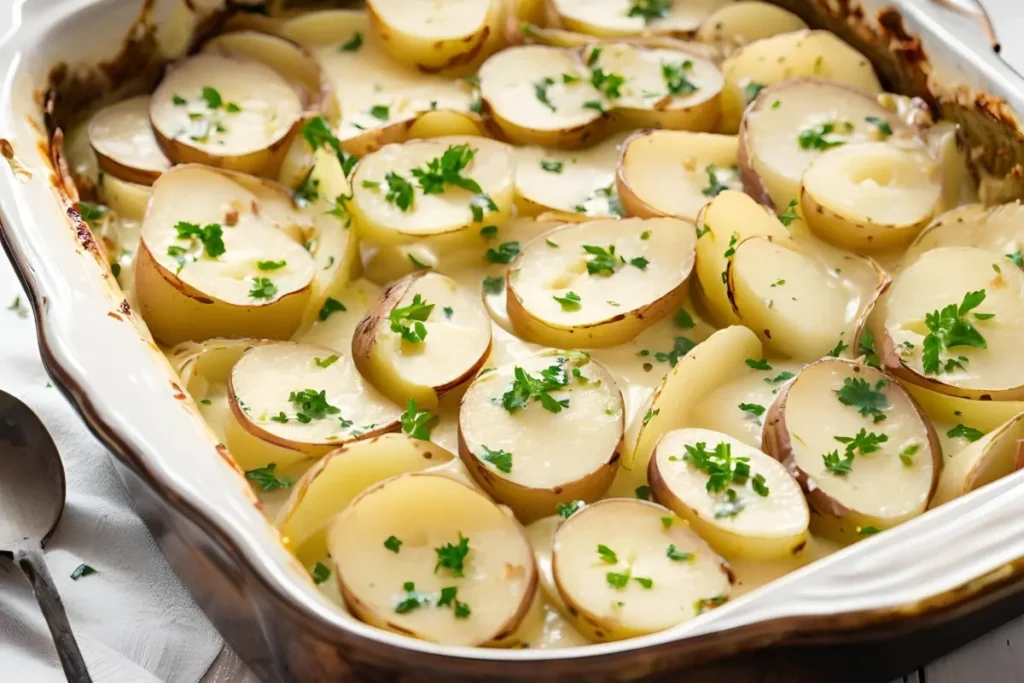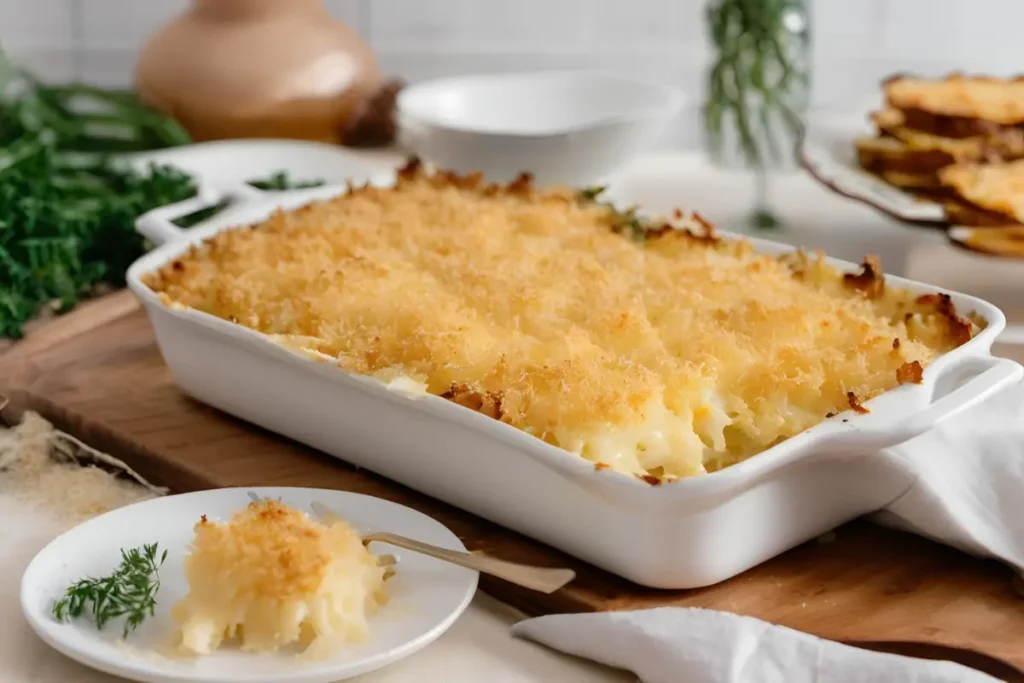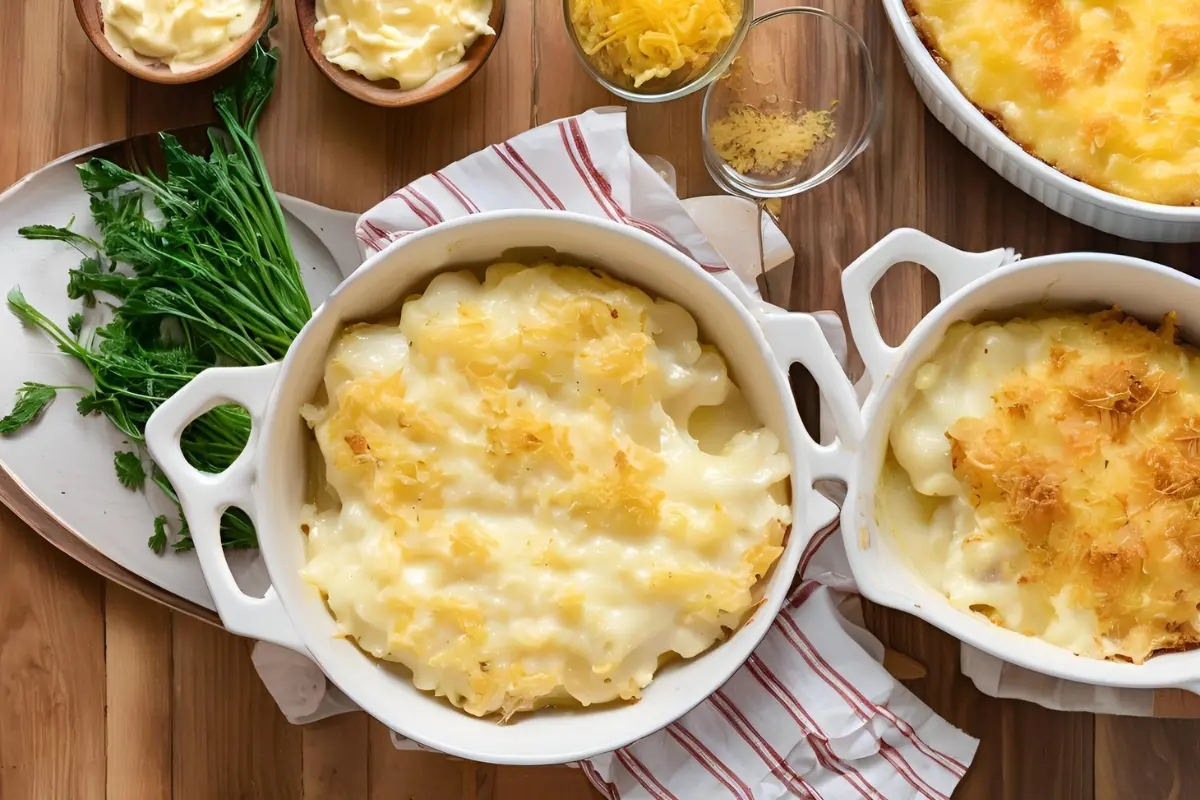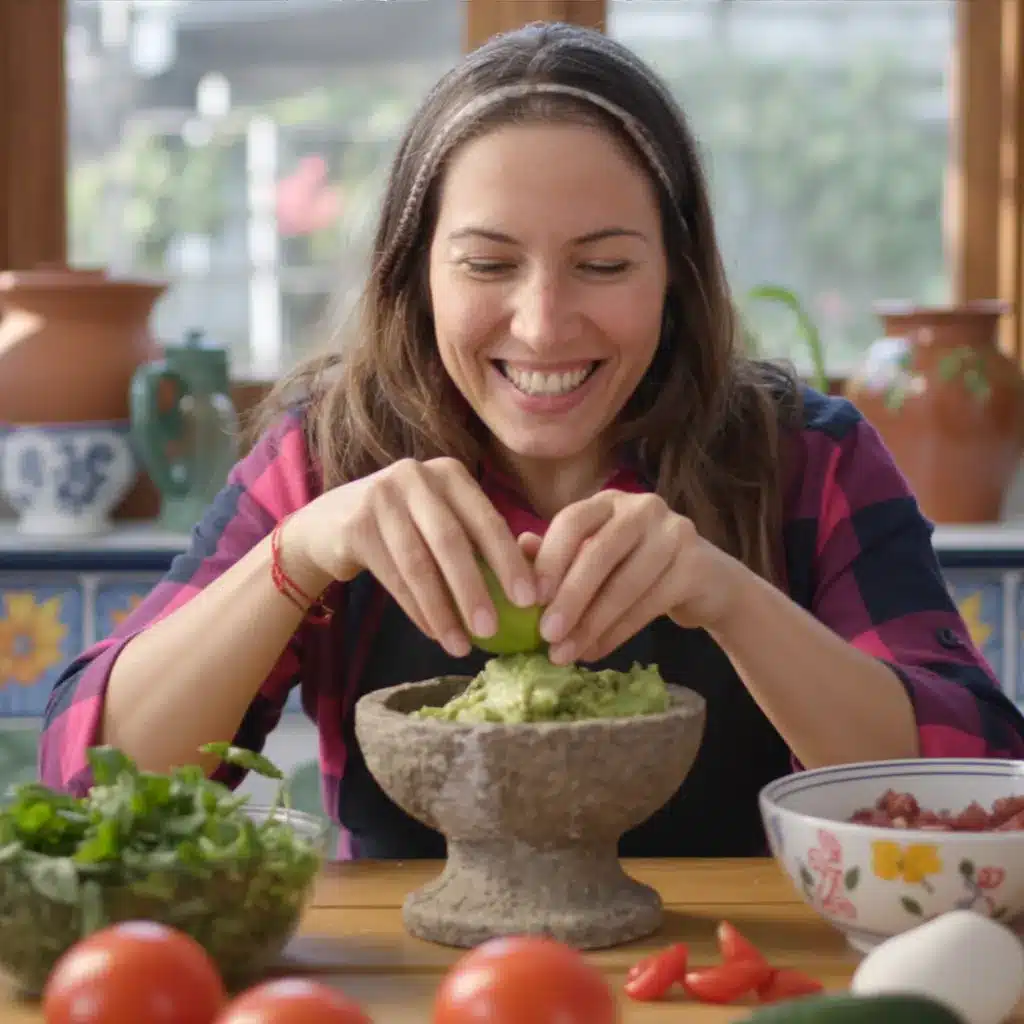Scalloped vs. au gratin potatoes—two dishes that look alike in the oven but tell very different stories on the plate. I still remember making both for a holiday dinner, thinking no one would notice the difference… until the cheesy, golden-topped au gratin vanished first, and the creamy, comforting scalloped was everyone’s “second helping” favorite. These potato classics share the same thin slices and oven-baked goodness, but their origins, ingredients, and textures give them each a personality of their own. Let’s explore what makes them unique so you can choose the perfect one for your next meal.
Understanding the Differences Between Scalloped Potatoes and Au Gratin Potatoes
Scalloped vs. Au Gratin Potatoes” – these two beloved comfort foods are often found on dinner tables during family meals and holiday celebrations. Despite their similarities, scalloped potatoes and au gratin potatoes have unique characteristics that set them apart. This article delves into their distinctions, origins, preparation, and uses.
Why Knowing the Difference Matters
Understanding the difference between scalloped and au gratin potatoes helps home cooks choose the right dish for any occasion. While both involve thinly sliced potatoes baked in a creamy sauce, their distinct ingredients and textures can change the dynamic of a meal. For instance, au gratin potatoes’ cheesy, crispy top may be better suited for a special dinner, while scalloped potatoes’ simplicity makes them ideal for casual meals.
Choosing the right dish also allows you to cater to dietary preferences or make the most of ingredients already on hand. Whether you’re cooking for guests or experimenting in the kitchen, knowing the difference ensures your dish aligns with your goals.
A Brief History of Scalloped and Au Gratin Potatoes
Origins of Scalloped Potatoes
Scalloped potatoes are believed to have originated in North America, with roots in traditional European cooking methods. The name “scalloped” likely refers to the scalloped edges of the potato slices, though it may also relate to the baking dishes historically used. This dish gained popularity for its simplicity, relying on basic ingredients like potatoes, cream, and butter to create a rich and comforting side.
The French Roots of Au Gratin
Au gratin potatoes, on the other hand, have distinctly French origins. The term “au gratin” translates to “with a crust,” referring to the browned, golden top achieved by adding cheese, breadcrumbs, or both. This cooking technique has been a staple of French cuisine for centuries, used not only for potatoes but also for vegetables, pasta, and even seafood.
French gratins traditionally relied on Gruyère or Parmesan cheese to achieve a nutty, savory flavor. Over time, the dish has evolved to include regional twists, making it a global favorite.
Who Should Care About These Potato Dishes?
Home Cooks Seeking New Recipes
For home cooks looking to expand their repertoire, understanding these dishes provides a foundation for experimenting with flavors and techniques. Both scalloped and au gratin potatoes are versatile, allowing for endless customization.
Food Enthusiasts Exploring Culinary Techniques
For food enthusiasts, the differences between these dishes offer an opportunity to explore classic culinary methods. Mastering the art of layering, sauce preparation, and achieving the perfect crust elevates your cooking skills while providing delicious results.
What Are Scalloped Potatoes?

Scalloped potatoes are a classic dish known for their simplicity and creamy texture. With a straightforward preparation method and minimal ingredients, scalloped potatoes have been a comforting addition to family dinners and holiday spreads for generations. Let’s explore the defining characteristics, variations, and adaptations of this beloved dish.
For more ideas on creating delicious side dishes, check out our guide on Betty Crocker Scalloped Potatoes.
Definition and Key Characteristics
Scalloped potatoes are characterized by thinly sliced potatoes baked in a rich, creamy sauce. While often confused with au gratin potatoes, scalloped potatoes are distinct for their minimal use of cheese and their reliance on cream-based sauces.
Sliced Potatoes in a Creamy Sauce
The foundation of scalloped potatoes lies in layering evenly sliced potatoes with a creamy sauce made from milk or cream. The sauce coats the potatoes as they bake, creating a tender, velvety texture. This simplicity makes scalloped potatoes an ideal side dish for pairing with a variety of main courses.
Minimal Use of Cheese in Traditional Recipes
Unlike au gratin potatoes, traditional scalloped potatoes typically exclude cheese. Instead, the dish relies on the richness of cream and butter to provide its signature flavor. Some modern recipes may incorporate cheese, but it is not a defining feature.
Common Variations and Adaptations
Over time, scalloped potatoes have evolved to include various ingredients and techniques, offering endless possibilities for customization.
Adding Vegetables or Herbs for Flavor
Incorporating vegetables like onions, garlic, or spinach can enhance the flavor of scalloped potatoes. Fresh herbs such as thyme, rosemary, or parsley add a bright, aromatic touch that complements the creamy base. These additions elevate the dish while maintaining its comforting essence.
Popular Modern Interpretations
Modern interpretations of scalloped potatoes often feature unique twists, such as substituting cream with coconut milk for a dairy-free version or adding spices like paprika or nutmeg for extra depth. Additionally, layering with breadcrumbs or crispy shallots provides a satisfying crunch.
What Is Au Gratin Potatoes?

Au gratin potatoes are renowned for their rich, cheesy flavor and golden, crispy top. While they share similarities with scalloped potatoes, au gratin potatoes stand out for their use of cheese and textural contrasts.
Definition and Unique Features
At its core, au gratin potatoes combine thinly sliced potatoes with layers of cheese and cream, topped with breadcrumbs or additional cheese for a crispy finish.
Heavy Use of Cheese in Layers
One of the defining characteristics of au gratin potatoes is the generous use of cheese. Cheddar, Gruyère, or Parmesan are commonly layered between the potato slices, melting during baking to create a rich, gooey interior.
The Importance of a Crispy, Golden Top
The hallmark of au gratin potatoes is their golden, crispy top. This crust is achieved by sprinkling breadcrumbs or grated cheese over the surface before baking. The contrast between the crispy exterior and creamy interior is what makes this dish so irresistible.
Historical and Regional Variations
While au gratin potatoes are a staple of French cuisine, regional adaptations have introduced new flavors and techniques.
French Techniques in Classic Gratin
Traditional French gratins often use simple, high-quality ingredients such as Gruyère cheese and cream. The emphasis is on balancing richness with a light, crispy texture, achieved through meticulous layering and baking.
Modern Twists on Au Gratin Potatoes
Modern recipes for au gratin potatoes include innovative ingredients like truffle oil, smoked cheese, or even alternative vegetables such as sweet potatoes. These adaptations demonstrate the versatility of the gratin technique, allowing it to evolve with contemporary culinary trends.
Key Differences Between Scalloped and Au Gratin Potatoes
While scalloped and au gratin potatoes share some similarities, their differences in ingredients, cooking techniques, and flavor profiles set them apart.
Ingredients
The primary distinction lies in the use of cheese and the preparation of the sauce.
Cheese Usage
Scalloped potatoes traditionally avoid cheese or use it sparingly, relying on the creaminess of milk or cream. In contrast, au gratin potatoes are defined by their layers of cheese, which contribute to their rich, savory flavor.
Sauce Preparation
Scalloped potatoes feature a cream-based sauce, while au gratin potatoes may include a cheese sauce or incorporate grated cheese directly into the layers. This difference significantly impacts the overall taste and texture.
Cooking Techniques
The methods used to prepare and bake scalloped and au gratin potatoes highlight their unique characteristics.
Layering and Baking Process
Both dishes involve layering thinly sliced potatoes, but au gratin potatoes include cheese between the layers. The baking process for au gratin potatoes often requires a longer cooking time to ensure the cheese melts evenly and the top becomes crispy.
Achieving the Signature Crust in Au Gratin
To achieve the perfect crust in au gratin potatoes, a combination of breadcrumbs and grated cheese is often used. Scalloped potatoes, however, focus more on the creamy consistency of the sauce and the tenderness of the potatoes.
Texture and Flavor Profiles
The final distinction lies in texture and flavor:
- Scalloped Potatoes: Creamy and tender, with a mild, buttery flavor.
- Au Gratin Potatoes: Rich, cheesy, and crispy, offering a more indulgent experience.
By understanding these key differences, you can choose the right dish to suit your preferences and occasion.
Choosing Between Scalloped and Au Gratin Potatoes
Deciding whether to serve scalloped potatoes or au gratin potatoes depends on several factors, including the meal’s occasion, pairings, and personal preferences. Both dishes bring something unique to the table, and understanding their strengths can help you make the right choice.
To discover additional tips for enhancing boxed potato mixes, visit our post on Boxed Scalloped Potatoes.
Factors to Consider When Deciding
When choosing between scalloped and au gratin potatoes, consider the occasion, the dietary needs of your guests, and the ingredients you have available.
Meal Pairings and Occasions
Scalloped potatoes are ideal for casual family dinners, as their mild flavor pairs well with roasted meats, poultry, or fish. On the other hand, au gratin potatoes are better suited for special events, where their richness and crispy topping can elevate the meal.
For example:
- Scalloped Potatoes: Serve with simple dishes like roasted chicken or baked pork chops.
- Au Gratin Potatoes: Pair with elegant entrees like beef tenderloin or glazed ham for a more decadent presentation.
Dietary Preferences and Ingredients on Hand
Scalloped potatoes use fewer ingredients and can be made without cheese, making them a lighter option for those watching their calorie intake. Conversely, au gratin potatoes are ideal for cheese lovers and those seeking a heartier dish. Additionally, the choice may come down to what’s in your pantry—scalloped potatoes require just cream and butter, while au gratin potatoes need cheese and breadcrumbs.
If you’re exploring new ways to pair rich potato dishes, consider our recommendations on Perfect Pasta Salad Tips.
When to Serve Scalloped Potatoes
Scalloped potatoes’ creamy, understated flavor makes them a versatile side dish for everyday meals.
Simple Comfort Food Dishes
For comfort food nights, scalloped potatoes pair wonderfully with meatloaf, grilled sausages, or pan-seared fish. Their creamy texture complements these dishes without overwhelming the plate.
Everyday Family Meals
Scalloped potatoes are an excellent option for busy weeknights. Their simple preparation and few ingredients make them a quick yet satisfying choice for family dinners. You can also add vegetables or proteins like ham to make them a one-dish meal.
When to Serve Au Gratin Potatoes
With their rich flavors and visually appealing presentation, au gratin potatoes are perfect for holidays and formal dinners.
Elegant Dinners and Holiday Feasts
The indulgent nature of au gratin potatoes makes them a popular choice for Thanksgiving, Christmas, or other celebratory meals. They pair particularly well with prime rib, turkey, or roast lamb. The crispy, golden crust adds a touch of sophistication to any table.
Impressing Guests with Culinary Flair
If you’re hosting a dinner party or trying to impress guests, au gratin potatoes are a show-stopper. The layering of cheese and the perfectly browned top demonstrate attention to detail and culinary skill.
Final Thoughts on Scalloped vs. Au Gratin Potatoes
Both scalloped and au gratin potatoes have their place in the kitchen, offering unique textures and flavors that cater to different occasions.
The Joy of Exploring Potato Recipes
Potatoes are one of the most versatile ingredients, and exploring recipes like scalloped and au gratin dishes allows you to experiment with various flavors and techniques. Each dish has its strengths, whether you’re seeking simplicity or indulgence.
Encouraging Creativity in the Kitchen
Cooking is an opportunity to express creativity. Whether you’re adapting a traditional scalloped potato recipe with new ingredients or experimenting with cheeses for an au gratin dish, the possibilities are endless. Feel free to try unique combinations, like adding truffle oil to au gratin potatoes or incorporating herbs into scalloped potatoes.
Ultimately, both dishes offer comfort and delight, making them timeless classics for any occasion.

Scalloped vs. Au Gratin Potatoes — Side-by-Side Guide + Two Recipes
Ingredients
Method
- SCALLOPED — Prep: Heat oven to 375°F (190°C). Butter a 9×13 in (23×33 cm) dish. Pat potato slices dry.
- Make creamy sauce (no cheese): In a saucepan, melt 2 tbsp butter over medium heat. Sauté onion 3–4 min; add garlic 30 sec. Stir in flour; cook 1 min. Gradually whisk in milk; simmer 3–5 min until lightly thickened. Season with salt, pepper, nutmeg, and thyme.
- Layer: Spoon a thin layer of sauce into the dish. Shingle in potatoes; ladle over sauce to fully coat. Repeat, ending with sauce.
- Bake to tender: Cover tightly with foil and bake 45–55 min until a knife slides in easily. Uncover and bake 10–15 min more to lightly golden. Rest 10 min before serving. (Grab a spoon and dive in — pure comfort in a bowl.)
- AU GRATIN — Prep: Heat oven to 375°F (190°C). Butter a 9×13 in dish. Toss panko with melted butter; set aside.
- Cheese sauce base: Melt 2 tbsp butter; stir in flour 1 min. Whisk in cream + milk; simmer 3–5 min until slightly thick. Off heat, stir in 1½ cups Gruyère/cheddar and half the Parmesan until smooth. Season with salt and pepper.
- Layer with cheese: Spread a thin layer of sauce in the dish. Add potatoes; sprinkle a little cheese; add more sauce. Repeat, ending with sauce. Top with remaining cheeses and buttery panko.
- Bake to bubbly + crisp: Cover 30–35 min until nearly tender. Uncover and bake 20–25 min more until deeply golden, bubbling, and knife-tender. Rest 10 min. Can you smell that? It’s as delicious as it smells!
Nutrition
Notes
Tried this recipe?
Let us know how it was!FAQs About Scalloped vs. Au Gratin Potatoes
1. Are au gratin or scalloped potatoes better?
Neither is universally better; it depends on the meal and your preferences. When considering scalloped vs. au gratin potatoes, scalloped potatoes are lighter and ideal for everyday dinners, while au gratin potatoes are richer and perfect for special occasions. Additionally, au gratin potatoes’ crispy top offers a textural contrast, whereas scalloped potatoes focus on creamy simplicity.
2. Why do they call them scalloped potatoes?
The term “scalloped” refers to the method of layering thinly sliced potatoes in a dish and baking them in a creamy sauce. In the debate of scalloped vs. au gratin potatoes, the name scalloped is rooted in its simplicity, often excluding cheese, which distinguishes it from its au gratin counterpart.
3. What makes a gratin a gratin?
A gratin is defined by its crispy, golden topping, achieved by baking with cheese, breadcrumbs, or both. The word “gratin” comes from the French term for a crusty layer, which enhances texture and flavor. When comparing scalloped vs. au gratin potatoes, this crust is a signature feature of au gratin dishes, offering a distinct difference from the creamy layers of scalloped potatoes.
4. Can you make scalloped potatoes without cream?
Yes, scalloped potatoes can be made without cream by using alternatives like chicken broth, milk, or dairy-free options such as almond or oat milk. This flexibility highlights one advantage in the scalloped vs. au gratin potatoes comparison—scalloped potatoes can be lighter and more versatile depending on dietary needs.
5. What’s the difference between scalloped and au gratin potatoes in a box?
Boxed scalloped potatoes typically include dehydrated potato slices and a seasoning mix for a creamy base. Boxed au gratin potatoes, however, emphasize a cheesy flavor, often including cheese powder in the mix. Both are convenient, but when comparing scalloped vs. au gratin potatoes, the boxed au gratin variety tends to be richer due to its focus on cheese.
6. Can you combine scalloped and au gratin styles in one dish?
Absolutely! You can layer cheese into a scalloped potato recipe and top it with breadcrumbs to create a hybrid dish. This creative approach blends the best of scalloped vs. au gratin potatoes, combining the creamy texture of scalloped potatoes with the cheesy, crispy elements of au gratin potatoes.
7. Are there healthier ways to prepare these dishes?
Yes, you can make these dishes healthier by using low-fat milk or cheese and incorporating vegetables like spinach, broccoli, or cauliflower. When deciding between scalloped vs. au gratin potatoes, scalloped potatoes may be a better choice for lighter, less calorie-dense meals, especially when cheese is omitted.
Stay Connected with Feel the Recipes
Love cooking and sharing good food? Let’s stay connected! Clara posts new recipes, helpful tips, and little moments from her kitchen every day to keep you inspired.
Join our growing community of home cooks who believe food is meant to be simple, joyful, and shared around the table.
👉 Facebook: Follow us on Facebook
📌 Pinterest: Explore our boards for endless recipe inspiration
🐦 X (Twitter): @feeltherecipes for quick tips and updates
📸 Instagram: @feeltherecipes for fresh photos and behind-the-scenes peeks
Let’s keep cooking, creating, and sharing. Whether you’re here for classic comfort food or something new to try, we’re just a click away.
